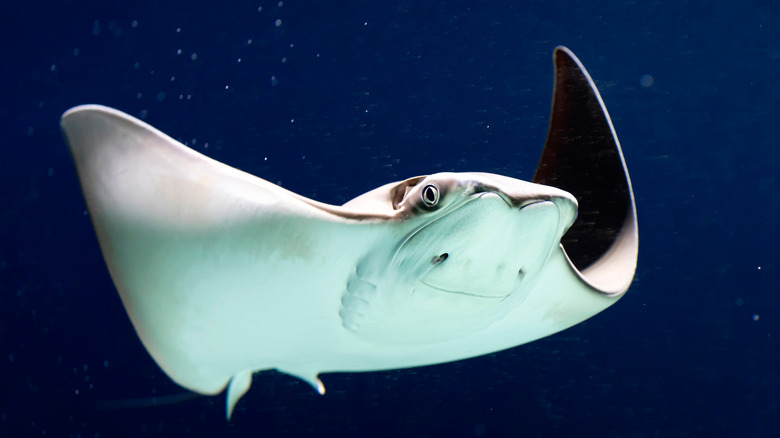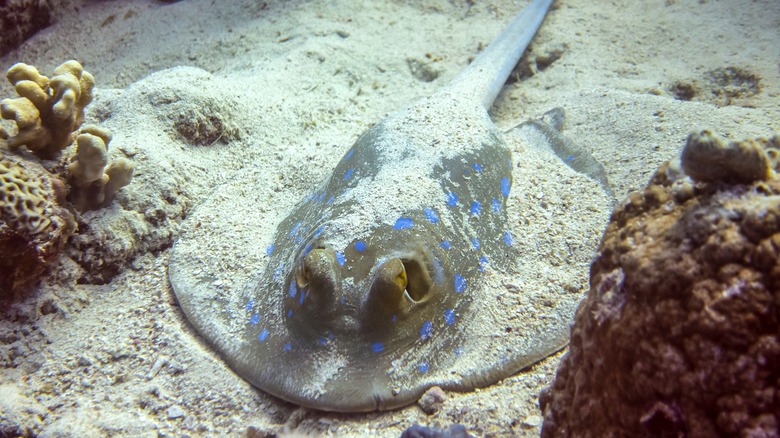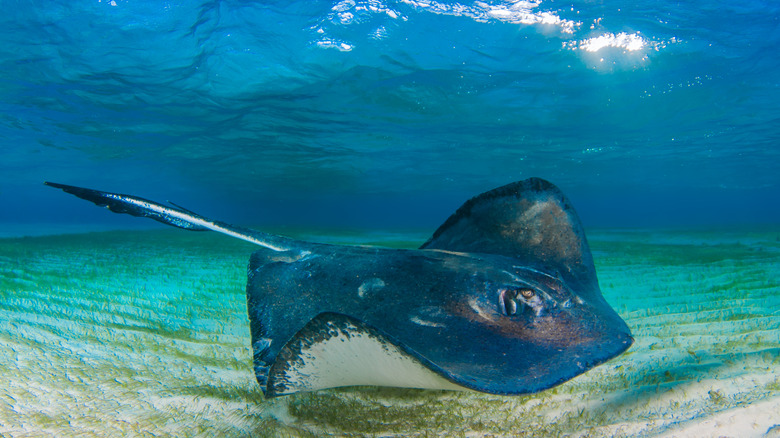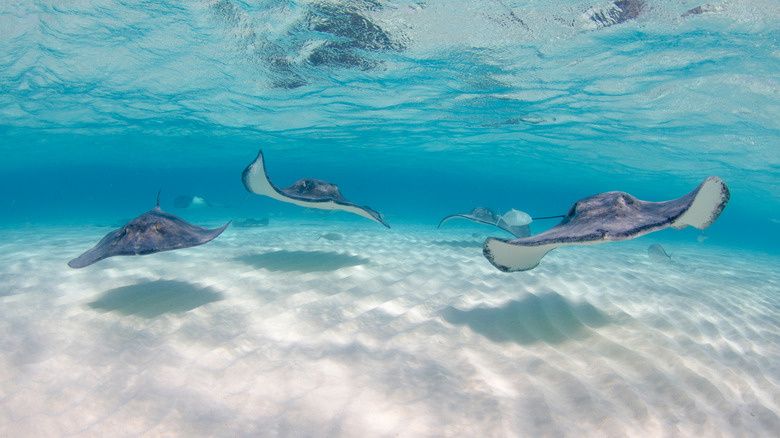What To Do If You're Injured By A Stingray
They can be found in temperate oceans, in freshwater rivers, or in a shallow petting tank at your nearby aquarium. Stingrays are some of the coolest, most interesting marine animals out there, fascinating to both kids and adults alike. And there's evidence that stingrays find people pretty cool, too: A research study done at Shedd Aquarium in Chicago indicated that the stingrays in their petting exhibit appear to seek out "backrubs" from visitors, according to WTTW.
But as cute as they are, stingrays can also be dangerous. Stingrays have barbs, like long tails, that are both sharp and loaded with venom, according to National Geographic. As a result, it's important to always be careful around stingrays, especially when you encounter them in the wild. Still, even if you avoid stingrays as strenuously as possible, you might find yourself stung or otherwise injured by a stingray. In these situations, it's important to remain calm and follow a few basic steps of medical care.
Where stingrays are found
Stingrays can make their home in many different areas of the world, depending on their specific species, according to AZ Animals. These large, flat animals eat their fellow fish, and can weigh up to a whopping 790 pounds, according to National Geographic, though there are also smaller varieties of stingrays that don't grow to be quite so hefty. Stingrays are closely related to another large marine carnivore, sharks.
Stingrays have lots of features which might be considered unusual. For instance, stingrays don't have any bones — only cartilage is used to shape their bodies (via AZ Animals). Similarly, though stingrays are fish, and most fish lay eggs, there are species of stingray which will give birth to pups.
Another sneaky trait of the stingray is its tendency to hide in the sand, according to National Geographic. This can make stingrays harder to spot and can lead to inadvertent encounters between humans and wildlife.
How to avoid a stingray injury
Whenever possible, it's good to try to avoid a potentially violent clash with a stingray. Though you might think stingrays, with their big barbed tails, are violent, in fact these creatures like to avoid confrontation with humans, according to Healthline. When they find a large animal, like a human, in their habitat, they're far more likely to swim away than to try to counterattack, according to AZ Animals.
Still, though many people try to avoid conflicts with stingrays, injuries sometimes happen. Oftentimes, these wounds can result from people inadvertently stepping on a stingray that was buried in the sand, causing it to react violently, according to the National Capital Poison Center. In the United States, around 2,000 injuries are reported each year from stingray encounters, though deaths are rare. Sometimes, people are injured because they are cut by the stingray's tail, but other times, they also get a dose of the stingray's venom. In either case, getting quick and competent medical care is very important.
How to treat a stingray injury
If you get injured by a stingray, don't panic. And certainly don't mix up stingrays and jellyfish. Your best first option when injured by a stingray is not to urinate on the wound. Instead, pay attention to where the injury is on your body, according to Healthline. If the stingray managed to catch you in a dangerous area, like on your neck or chest, you should head straight to the hospital. Similarly, if you start to feel any allergic symptoms, like a swelling in your throat, you should head to the E.R., since you may be allergic to stingray venom.
However, if your injury, like most stingray injuries, has occurred on your foot or leg, and you feel no allergic symptoms, you can begin to treat the wound yourself, according to the National Capital Poison Center. First, be sure to wash the wound thoroughly, to prevent infection. Then check the wound to see if any bits of the stingray's barb got left behind in your wound. Once you've thoroughly cleaned the area, you might find you are experiencing some lingering pain from the stingray venom. In that case, try soaking your wound in hot water. This treatment has been shown to help alleviate the venom-related pain. Stingray wounds usually heal relatively quickly — within a few days or weeks.
Famous people who have been stung by stingrays
Though the vast majority of stingray injuries are nonfatal, there are some exceptions to this rule, including the widely publicized case of Steve Irwin, according to Biography. Irwin was a famous wildlife advocate who worked for the Australian Zoo and who had his own TV show, "The Crocodile Hunter," on which he shared his love for reptiles and other wildlife. However, tragedy struck in 2006, when, while filming a documentary in Queensland, Australia, Irwin had a deadly encounter with a wild stingray. Irwin got into the water to swim with the stingray when it mistook him for a threat. The stingray plunged its barb into Irwin's chest, injuring Irwin's heart, according to All That's Interesting. His crew attempted to rush him back to a hospital in time to save his life, but Irwin died on the boat.
Other freak accidents with stingrays have also been reported to have led to the death of the victim, including one incident in which a diver at an aquarium in Singapore was killed by the animal in its tank, according to the Chicago Tribune. Like Irwin, the diver, Phillip Chan, was killed from a puncture wound to the chest, not by the animal's venom.
Stingrays in myth
Stingrays can also be popular figures in myths, including in one of the most famous myths of all time, "The Odyssey," by Homer. "The Odyssey" follows its titular character, Odysseus, over the course of a decade as he attempts to return home to his native Ithaca after the end of the Trojan War, according to World History Encyclopedia.
On his quest to return home, Odysseus fathers a son, Telegonus, with the goddess Circe, according to Britannica. Later, after Odysseus has returned to Ithaca, Telegonus, who never knew his father, goes to seek him out. Before he sets out to find him, his mother, Circe, gives Telegonus a spear (via Encyclopedia Mythica). This spear is tipped with the barb of a deadly stingray. When Telegonus encounters his father, not recognizing him, he ends up killing him with this stingray barb, cementing an ultimately tragic fate for the famous Greek hero.





